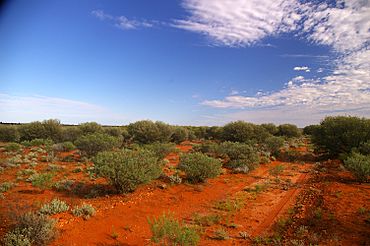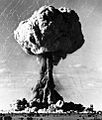Maralinga facts for kids
Quick facts for kids MaralingaSouth Australia |
|
|---|---|

Landscape of Maralinga site
|
|
Maralinga is a large desert area in the west of South Australia. It's part of the Great Victoria Desert and covers about 3,300 square kilometers. Maralinga is famous because it was the site of several British nuclear tests in the 1950s.
In 1985, the land was given back to its original owners, the Maralinga Tjarutja people. They are an Aboriginal Australian group. Around the same time, a special investigation found that some areas were still affected by nuclear contamination. The governments of the United Kingdom and Australia worked together to clean up the site. The Maralinga people moved back to the land in 1995, with their main community now at Oak Valley. Even after two cleanups, some people are still worried that parts of the land might not be completely safe.
Contents
History of Maralinga
Nuclear Testing and Cleanup Efforts
Maralinga was used by the United Kingdom for testing nuclear weapons in the 1950s and early 1960s. This left the area with radioactive waste. Before Maralinga, tests were done at Emu Field further north.
On September 27, 1956, a series of tests called Operation Buffalo began at Maralinga. This operation included testing four fission bombs, which are powerful bombs that split atoms. Some bombs were placed on towers, one on the ground, and one was dropped from an airplane. This was the first time Britain dropped an atomic weapon from a plane.
Another series of tests, Operation Antler, happened in 1957. These tests checked how the weapons' triggering systems worked. Three tests took place, with bombs suspended from towers or balloons. The power of these bombs ranged from 1 to 25 kilotons. A kiloton is a measure of explosive power, equal to 1,000 tons of TNT.
People involved in these tests were not allowed to talk about them. However, a nuclear veteran named Avon Hudson bravely spoke out in the 1970s. He became a whistle-blower, someone who reveals secret information. His actions helped lead to a public investigation into the tests and their long-term effects.
A special investigation called the McClelland Royal Commission in 1984–1985 found a lot of leftover contamination. British and Australian soldiers were sometimes exposed to the radiation on purpose to study its effects. The local Aboriginal people said they were harmed by the tests. In 1994, the Australian Government paid the Maralinga Tjarutja people $13.5 million as a settlement for the harm caused by the nuclear testing. Many of these facts were kept secret from the public for a long time.
Land Handback to Traditional Owners
In January 1985, the land was officially given back to the traditional owners, the Aboriginal people of the area. They are known as the Aṉangu people, a southern group of the Pitjantjatjara people. This happened under the Maralinga Tjarutja Land Rights Act 1984. They received full ownership of the land and money from the government to help them develop their communities.
The Maralinga Tjarutja people moved back to Oak Valley in March 1985. This new community is about 128 kilometers northwest of the original Maralinga town.
In 1995, the UK and Australian governments agreed to clean up the site again. They buried tons of soil and debris containing plutonium and uranium in deep trenches. However, people have often questioned how effective this cleanup really was.
In 2003, a new school was opened at Oak Valley. This replaced an old school that was in very poor condition.
Ongoing Contamination Concerns
Even after two cleanup programs paid for by the Australian and UK governments, there are still worries. Some areas of the Maralinga test sites might still be contaminated, even though they were declared "clean" as recently as 2011.
In 2021, scientists found that tiny radioactive particles are still in the soil. An international team used a special machine at Monash University to study tiny samples. This machine can slice open samples using a beam of high-energy ions. The study suggested that natural processes in the desert might slowly release plutonium over a long time. This plutonium could then be absorbed by animals living in Maralinga.
Climate in Maralinga
- Temperatures can range from 6.5°C in winter to 44.7°C in summer.
- Winter nights can get very cold, sometimes reaching -3°C.
- The average rainfall is between 75 and 125 millimeters per year.
Documentary Film About Maralinga
A television documentary film called Maralinga Tjarutja was released in May 2020. It was directed by Larissa Behrendt and made by Blackfella Films for ABC Television. The film tells the story of the Maralinga Tjarutja people.
It was shown around the same time as a drama series called Operation Buffalo. The documentary aimed to share the Indigenous people's side of the story and show how the nuclear tests changed their lives. Reviewers praised the film, calling it an "excellent documentary."
The film highlights the strength of the Maralinga Tjarutja people. Their elders share a deep understanding of time and place, showing respect for their sacred land. Their ancestors have lived in the area for thousands of years. Despite the British and Australians ignoring their rights to the land during the testing, the people have continued to fight to protect their contaminated land.
Images for kids



